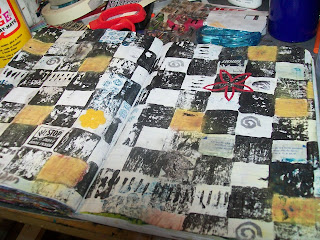
If you look at the page featured in today's post, you'll see that the style is a little more streamlined than most of my other pages - most of the ones that I do on a regular basis are a more grungy, distressed feeling page, while the page that I'm showcasing today is quite different. Sure it's got a few of those things, but there's a lot more straight, planned lines, with my style inside of them. I actually created this page as a challenge page. Over on Ky's blog, she told us that our challenge was to showcase a checkerboard. A lot of times, at least for me, when I'm told something like that, an idea normally pops into my head, and I feel that it's my responsibility to put it on paper. So I got an idea, and I just decided that I'd go with it, whether I felt like it or not. But a lot of times when I get such an idea, I automatically go crazy - I feel it's my duty to let it free, and it's me holding such a wonderful idea from sprouting.
Another note about using a different style every now and again in your art journals is that it gives you a new feeling of accomplishment - and if you always do the same kind of pages, then it gives you the feeling that you actually can do something other than what's in the zone that you are comfortable with. And when you learn this; that you can do it, and that you can take it to the next level. So go out of your comfort zone today - do a page idea that you've had in your mind for a while now, but have been afraid to use. Trust me. I know.










